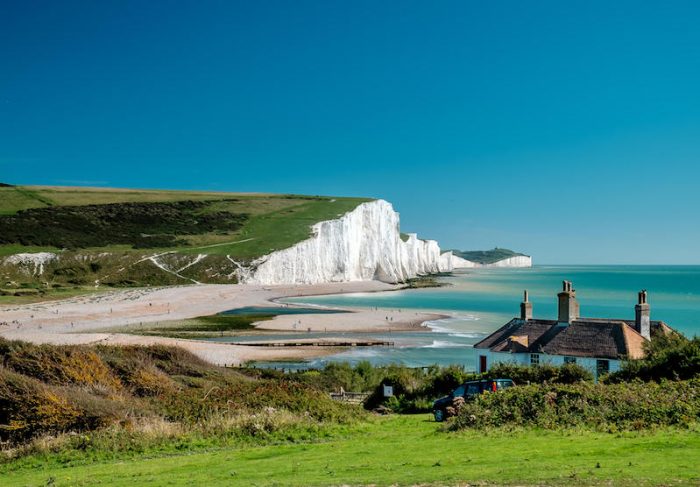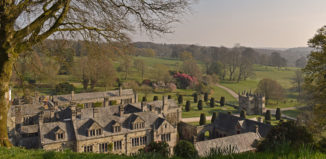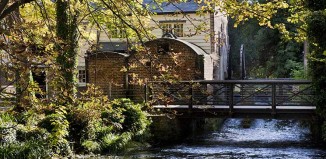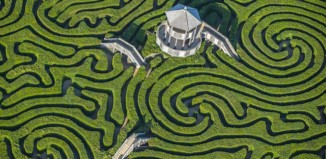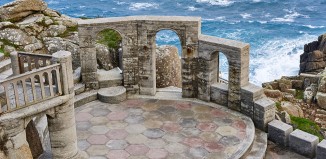Discover Britain’s coastal jewels
From blue lagoons and sea stacks to outdoor theatres and historic lighthouses, Steve Pill charts a course around 7 gems found on the British coast
For natural engineering feats…
Durdle Door, Lulworth, Dorset
According to the Jurassic Coast Trust, the independent charity that manages the Jurassic Coast World Heritage Site, Durdle Door was formed as a result of the same geological process that gave us the Alps. It is thought that when the African and European tectonic plates collided some 25 million years ago, the pressures not only created the central European mountain range but also rippled outwards to form more gentle rifts along the British coast.
The frame of the Door is a hard limestone layer rising up from the English Channel between the resort towns of Swanage and Weymouth. Less resilient rock at the centre was eroded to create this most unlikely natural aperture at the end of Durdle Cove’s sweep of sand-and-shingle beach. While many photographers favour the viewpoint from the chalky lower cliffs around the cove or even flat shots across the beach to the Door, Swyre Head offers a more comprehensive view of this particular stretch of Jurassic coastline, allowing you to place Durdle Door in the context of the dramatic slopes at St Oswald’s Bay and the haphazard rocks of Dungy Head.
Durdle Door is part of the 12,000-acre Lulworth Estate that also contains the luminous blue-green waters of Lulworth Cove and the 17th-century Lulworth Castle with its rose garden and excellent tearoom.
For dramatic light…
Tarbat Ness, Easter Ross, Scotland
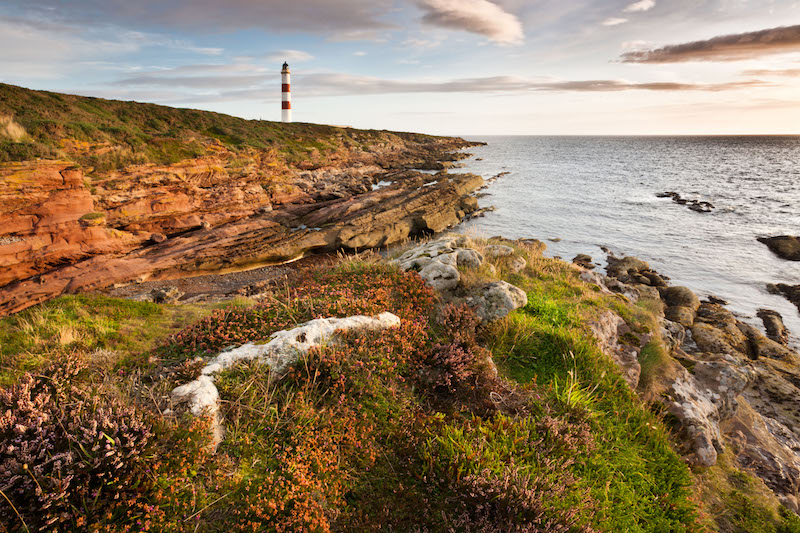
Around 130 bottlenose dolphins are thought to live in the Moray Firth, an inlet to the northeast of Inverness, yet spotting them is tricky. A far more reliable sight can be found further up the coast on the Tarbat Ness peninsula. Here, the Tarbat Ness Lighthouse has been shining out continuously for 188 years, guiding ships past the sandbar of Gizzen Briggs.
With its two distinctive red bands, the lighthouse was commissioned following the loss of more than a dozen vessels in the storms of 1826. At 41 metres, Tarbat Ness is the third tallest lighthouse in Scotland and one of 16 designed by famed engineer Robert Stevenson.
The setting truly makes this a jewel of the coast, however. A pleasing nine-mile circuit can be walked from Portmahomack and there is a rich history to the area, too. Previously, the site of a Roman fort and an 11th-century Viking battle, the more dubious tales of witch covens meeting here simply add to the mystique.
For distracting views…
Minack Theatre, Porthcurno, Cornwall
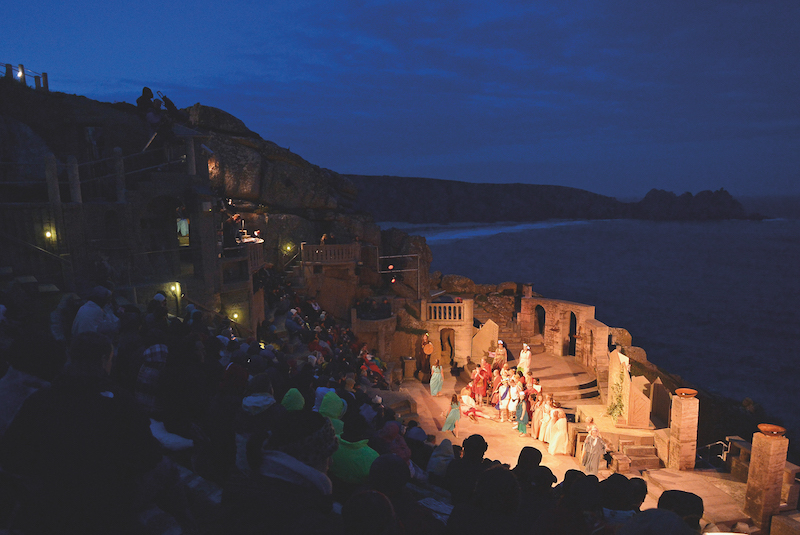
Staring at the scenery during a play is normally a damning verdict. At the Minack Theatre, however, it is entirely understandable. This 750-seater venue was dug out the Cornish cliffs so performances play out over the sounds of the Atlantic Ocean – imagine a quainter, coastal version of Colorado’s Red Rocks Amphitheatre.
We have the extraordinary vision of Rowena Cade to thank for this incredible venue. Inspired by a local performance of A Midsummer Night’s Dream, she decided the cliffs below her garden at Minack House would provide a far grander setting. During the mild winter of 1931, Cade and her gardener set about lifting granite boulders to create the grassy stage and terrace seating that remain largely the same today.
Cade died in 1983, yet the Minack Theatre Trust ensures a summer season of shows in all weathers. This year’s highlights include, suitably for the setting, Gilbert & Sullivan’s The Pirates of Penzance (17-21 September).
For heady heights…
Seven Sisters, Near Seaford, East Sussex
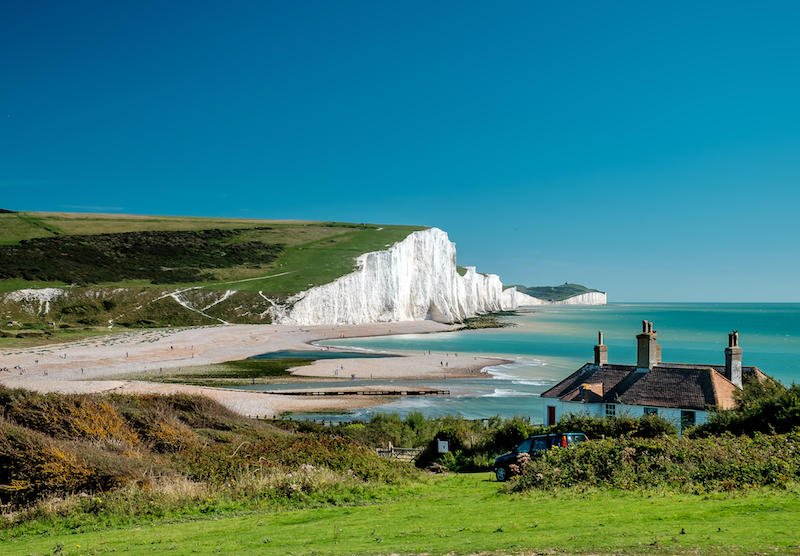
In the 17th and 18th centuries, smugglers could often be found navigating the channels at Cuckmere Haven and Birling Gap. All manner of French contraband, from brandy to lace, would pass through these two narrow gaps in the Sussex cliffs, having made its way across the English Channel away from prying eyes.
Standing on the shallow ridge at Cuckmere Haven today, next to the Coastguard Cottages whose former tenants helped put an end to such illegal activity, it is hard to imagine a more conspicuous place for pirates to frequent. After all, it is between these two inlets that the Seven Sisters cliffs rise and fall, a beacon of chalky white that gleams brightly against even the greyest skies that England can muster.
The White Cliffs of Dover, Kent, may be Britain’s most iconic stretch of chalk coastline, particularly following the Second World War when it became a symbol of resistance, yet it is a difficult sight to truly see without venturing out to sea and the ridge is a rather uniform height. The undulating Seven Sisters, by contrast, can be viewed in its entirety from miles around, whether looking east from Seaford or west from Beachy Head. The latter, in particular, offers widescreen views to Kent and the Isle of Wight from the top of the headland, as well as 162 metres down to the rocky shore and a lighthouse below.
The Seven Sisters Country Park offers wide-ranging possibilities for walkers, including heading inland to the dense Friston Forest, though the most popular route picks up part of the 100-mile South Downs Way national trail and takes you across the chalk cliff crests. From west to east, they are: Haven Brow (the tallest at 77 metres), Short Brow, Rough Brow, Brass Point, Flagstaff, Flat Hill, Bailey’s Hill and Went Hill. The more observant will note eight names rather than seven, the extra peak having occurred following erosion.
At either end, Seaford Head Nature Reserve is 83 hectares of grassland dotted with nesting birds and wildflowers, while Birling Gap has a well-appointed National Trust café at which you can admire the view from the veranda.
For those who rock…
Fingal’s Cave, Staffa, Inner Hebrides

The tiny island of Staffa is uninhabited, unless you count the various guillemots, fulmars and puffins that nest here. For non-avian visitors, the main attraction is Fingal’s Cave, an 82-metre-deep sea cave made distinctive by the hexagonal basalt pillars of its interior walls.
The cave was discovered in 1772 and named after the hero of James Macpherson’s Fingal – An Ancient Epic Poem in Six Books, an apparent translation of 3rd-century texts by Ossian that inspired the Romantic movement and have since been dismissed as a literary hoax. Nevertheless, by the Victorian era, the cave had become quite the destination with visits by artist JMW Turner, Treasure Island author Robert Louis Stevenson and even Queen Victoria.
Following an 1829 trip, the cave’s unique acoustics led the German composer Felix Mendelssohn to write one of his most stirring works, The Hebrides (Fingal’s Cave). The contrasting dramatic melodies and calmer passages provide an awesome soundtrack to a visit, with Staffa Tours organising daily boat rides from several other Hebridean islands.
For wild swimmers…
Abereiddy, Near Haverfordwest, Pembrokeshire
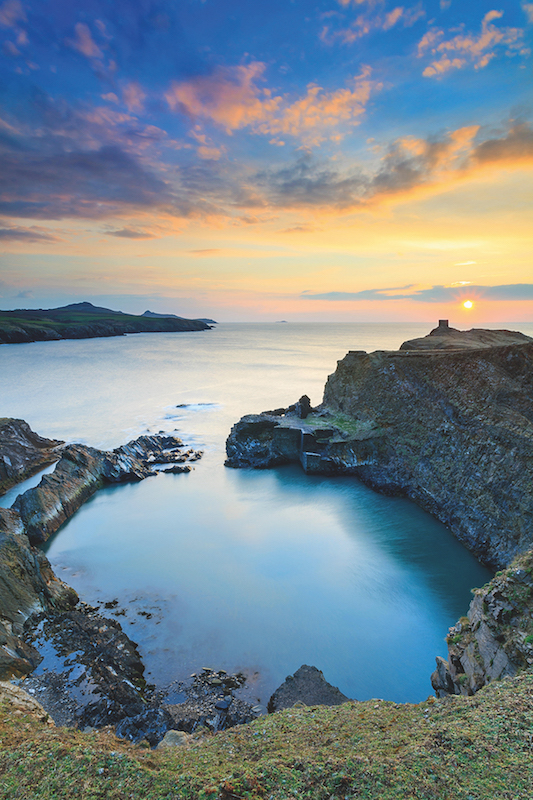
What initially appears to be a natural oasis on the west Wales coastline is, in fact, an old quarry breached by the sea. Rather than being blessed by a tropical climate, the deep cerulean waters – known as the ‘Blue Lagoon’ – are a reflection of the pounded slates once mined at St Brides quarry, which was active until 1910.
The surrounding landscape is dotted with reminders of this time, from derelict workers’ cottages to the overgrown tramway lines that linked St Brides to nearby Porthgain. The remnants of the quarry’s old wheelhouse on the side of the sea inlet provides locals with a three-tiered platform from which to dive into the lagoon. Spectators can watch divers jumping from a far higher board constructed on the quarry side for the annual Red Bull Cliff Diving World Series, which has been held here several times since 2012.
While in the area, be sure to enjoy the bluebell woods of Abermawr beach and the bracing views across Abercastle harbour.
For stacks of fun…
The Needles, Isle of Wight

The name of this particular coastal jewel is rather misleading. While ‘needles’ conjures up images of slender pin-like points, these three chalk stacks are far more muscular and substantial, worn tough by the Atlantic currents drifting into the Solent. The name actually came from a finer, fourth stack that collapsed in 1764. (As the National Trust poetically puts it: “You can see the gap very clearly, like a missing tooth.”)
What the remaining trio lacks in refinement, it more than makes up for with sheer audacity. Towering 30 metres above the waves, these white outcrops are the remnants of a chalk ridge that is thought to have once connected the Isle of Wight with the mainland.
The best views can be had from the Old Battery, a Victorian coastal fort used during both world wars, while the adjacent grassy ridge was named Tennyson Down after the Romantic poet Alfred, Lord Tennyson. He lived for almost 40 years at the nearby Farringford House (now a splendid museum to his life and work) and famously declared the fresh local air to be worth “sixpence a pint”.

